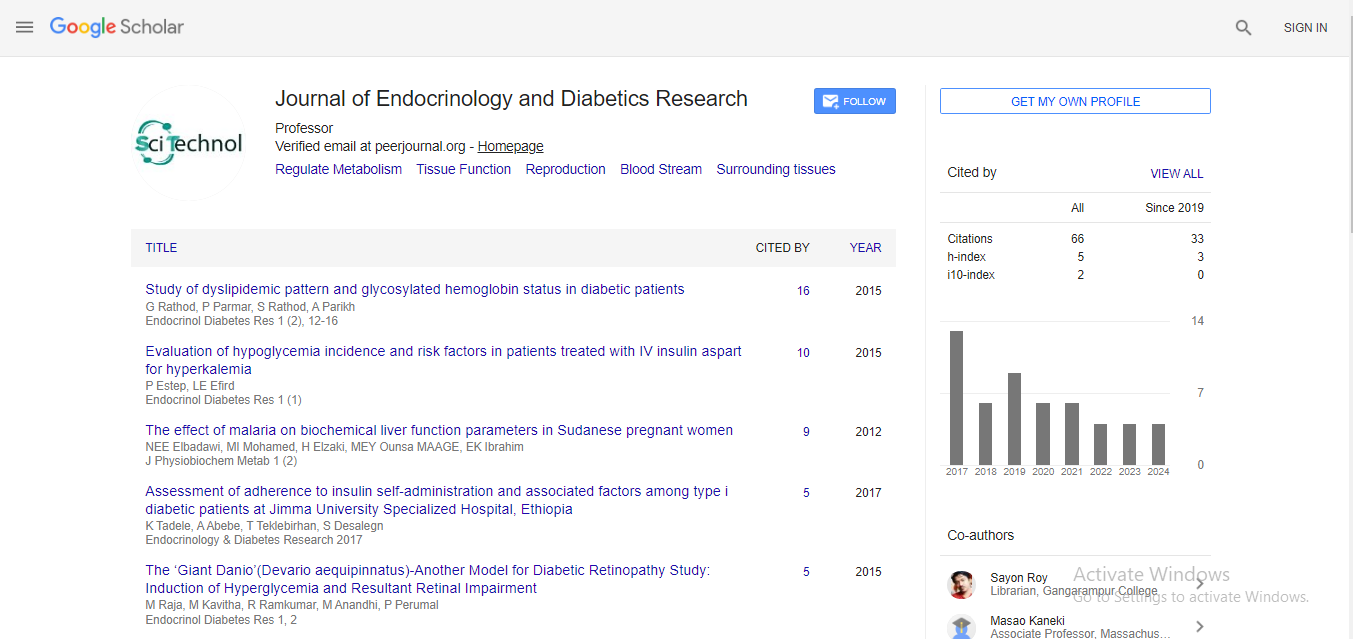Short Communication, Endocrinol Diabetes Res Vol: 7 Issue: 11
The Body Tightly Regulates Blood Glucose levels as a Part of Metabolic Homeostasis
The glycaemia, also known as blood sugar level, blood sugar concentration, or blood glucose level is the measure of glucose concentrated in the blood of humans or other animals. Approximately 3.7 grams of glucose, a simple sugar, is present in the blood of a 64 kg (141 lb) human at all times In humans, a blood glucose level of 4 grams, or about a teaspoon, is critical for normal function in a number of tissues, and the human brain consumes approximately 60% of blood glucose in fasting, sedentary individuals. A persistent elevation in blood glucose leads to glucose toxicity, which contributes to cell dysfunction and the pathology grouped together as complications of diabetes Glucose can be transported from the intestines or liver to other tissues in the body via the bloodstream Cellular glucose uptake is primarily regulated by insulin, a hormone produced in the pancreas Glucose levels are usually lowest in the morning, before the first meal of the day, and rise after meals for an hour or two by a few millimoles. Blood sugar levels outside the normal range may be an indicator of a medical condition. A persistently high level is referred to as hyperglycemia; low levels are referred to as hypoglycemia. Diabetes mellitus is characterized by persistent hyperglycemia from any of several causes, and it is the most prominent disease related to the failure of blood sugar regulation. There are different methods of testing and measuring blood sugar levels. Normal value ranges may vary slightly between laboratories. Many factors affect a person's blood sugar level. The body's homeostatic mechanism of blood sugar regulation (known as glucose homeostasis), when operating normally, restores the blood sugar level to a narrow range of about 4.4 to 6.1 mmol/L (79 to 110 mg/dL) (as measured by a fasting blood glucose test).
Abstract
The glycaemia, also known as blood sugar level, blood sugar concentration, or blood glucose level is the measure of glucose concentrated in the blood of humans or other animals. Approximately 3.7 grams of glucose, a simple sugar, is present in the blood of a 64 kg (141 lb) human at all times In humans, a blood glucose level of 4 grams, or about a teaspoon, is critical for normal function in a number of tissues, and the human brain consumes approximately 60% of blood glucose in fasting, sedentary individuals. A persistent elevation in blood glucose leads to glucose toxicity, which contributes to cell dysfunction and the pathology grouped together as complications of diabetes Glucose can be transported from the intestines or liver to other tissues in the body via the bloodstream Cellular glucose uptake is primarily regulated by insulin, a hormone produced in the pancreas Glucose levels are usually lowest in the morning, before the first meal of the day, and rise after meals for an hour or two by a few millimoles. Blood sugar levels outside the normal range may be an indicator of a medical condition. A persistently high level is referred to as hyperglycemia; low levels are referred to as hypoglycemia. Diabetes mellitus is characterized by persistent hyperglycemia from any of several causes, and it is the most prominent disease related to the failure of blood sugar regulation. There are different methods of testing and measuring blood sugar levels. Normal value ranges may vary slightly between laboratories. Many factors affect a person's blood sugar level. The body's homeostatic mechanism of blood sugar regulation (known as glucose homeostasis), when operating normally, restores the blood sugar level to a narrow range of about 4.4 to 6.1 mmol/L (79 to 110 mg/dL) (as measured by a fasting blood glucose test).
 Spanish
Spanish  Chinese
Chinese  Russian
Russian  German
German  French
French  Japanese
Japanese  Portuguese
Portuguese  Hindi
Hindi 


